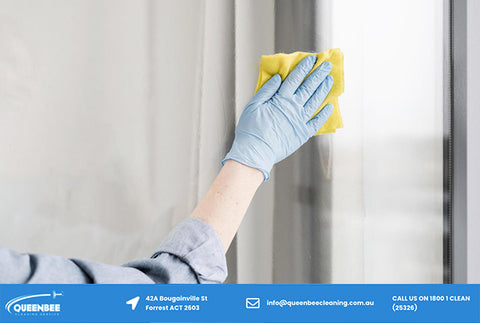What Are The 7 Steps Of Office Cleaning?
There are seven rules that apply regardless of the space that requires cleaning, whether commercial, industrial, or a small office. The 7-step cleaning procedure is the cleaning industry standard. It is a broad approach used by experts to deal with a variety of situations.
However, not all places are designed to be cleaned in the same way. Despite the ultimate objective of removing all dirt and bacteria, certain areas in the office have considerably more rules than others. As a result, QueenBee will show you the process and its relation to different areas in your office in this article.

1. Remove Trash
Waste removal is the first step to do before any office cleaning. Emptying and discarding garbage bags and liners is the first step. The interior section of the container must then be properly cleaned after that. Finally, a new bag should be used to replace the bin liner.
2. Start with dusting at a higher level
The next step is to dust anything above shoulder level in the office, moving in a clockwise or counterclockwise direction. This is done to avoid wasting the later cleanup of the lower portions, as the additional dirt and dust that would be spilled would necessitate additional cleanup. This also makes moist mopping much simpler, similar to brushing dirt off a floor before mopping.
3. Use a damp swab
The next step is to clean all high-touch surfaces which appear in your office using a moist cloth soaked in a neutral disinfectant, except for glass surfaces. Light switches, phones, doorknobs, and workstations in the case of an office are all examples of hi-touch surfaces. Because of the risk of germs concentrating on these surfaces, this is a critical step of office cleaning. Here's where you can learn more about the frequent areas where germs congregate.

4. Restock products and items
Following the cleaning of the high-touch surfaces, the following stage necessitates some form of refill. Bathroom products such as toilet paper, paper towels, and soaps, which help in general cleaning, must be replenished for two reasons. One benefit is that having publicly available cleaning supplies can help prevent the spread of bacteria and other contagions. The second is, of course, to uphold social norms and make your office more comfortable.
5. Dust mop or clean the floor level
It's time to move on to the lower regions in your office, including the floor, when all the shoulder level/high surfaces have been cleaned. This phase entails sweeping floor dust using dust or dry mop to simplify the next step. Again, bulky things and blocking objects must be avoided, and no dirt must be left uncollected in any corner, as this is a health danger.
6. Examine the entire area for any missing steps
Before moving on to the last stage, take a stroll around the office and examine it for any extra cleaning or anything damaged or out of the norm. Canberra's professional office cleaning staff is not obligated to restore any damaged objects; nevertheless, the owner must notify of any damages. Damages discovered early in this stage do not interfere with the wet mopping procedure, taking longer if dirt is dragged over the floor.
7. Wash any wettable floor surface with a damp mop
The wet mopping technique is the final stage in cleaning an office space, and it imparts a sheer gloss to the floor. Pour a neutral or diluted cleanser into a cleaning bucket (like bleach and lots of water, but never mix bleach with other cleaners). To avoid treading on the wet floor, mop around the perimeter of the premises as much as possible, then pursue the center by poking toward the center in an eight-sided star form. After that, the floor must be allowed to air dry.
Follow the same technique in the restrooms, but be sure to disinfect all surfaces. Also, insert your toilet bowl cleaner in the bowl and urinals first before entering a bathroom. Allow it to rest for a few minutes before washing down the surfaces. When cleaning the toilet bowl, use a bowl brush and do not use the same cleaning cloth on any other surface after scrubbing the toilet bowl.
Tips:
- Use a cream cleaner to remove hard water deposits or stains from your porcelain or stainless steel.
- Use a backpack vacuum with a brush to clean dirty porous drop ceilings. This will allow you to remove the dust without breaking the tile or allowing debris to fall.
- When supervisors do inspections, I advise them to check the trash can first, then look at the high dusting, surfaces, and floors.
Conclusion
Although offices come in a variety of designs, these professional spaces can provide some specific problems. The 7-rules still apply to disinfecting high-touch surfaces such as phones, laptops, desks, doorknobs, and so on. If carpet is the primary flooring choice in the area, this might be a stumbling block. Carpets may be vacuumed for routine cleaning, but extra tools and procedures may be required to remove extremely soiled carpet areas.
Following these standard practices will guarantee that an office is adequately cleaned. And all the Canberra cleaning officers or professional cleaning employees can apply these rules to start cleaning any office.
QueenBee Cleaning Pty LTD
- 42A Bougainville St Forrest ACT 2603
- 3/5 Daphne close Kingswood NSW 2747
- Hotline: 1800 1 CLEAN (25326)
- Email: info@queenbeecleaning.com.au
